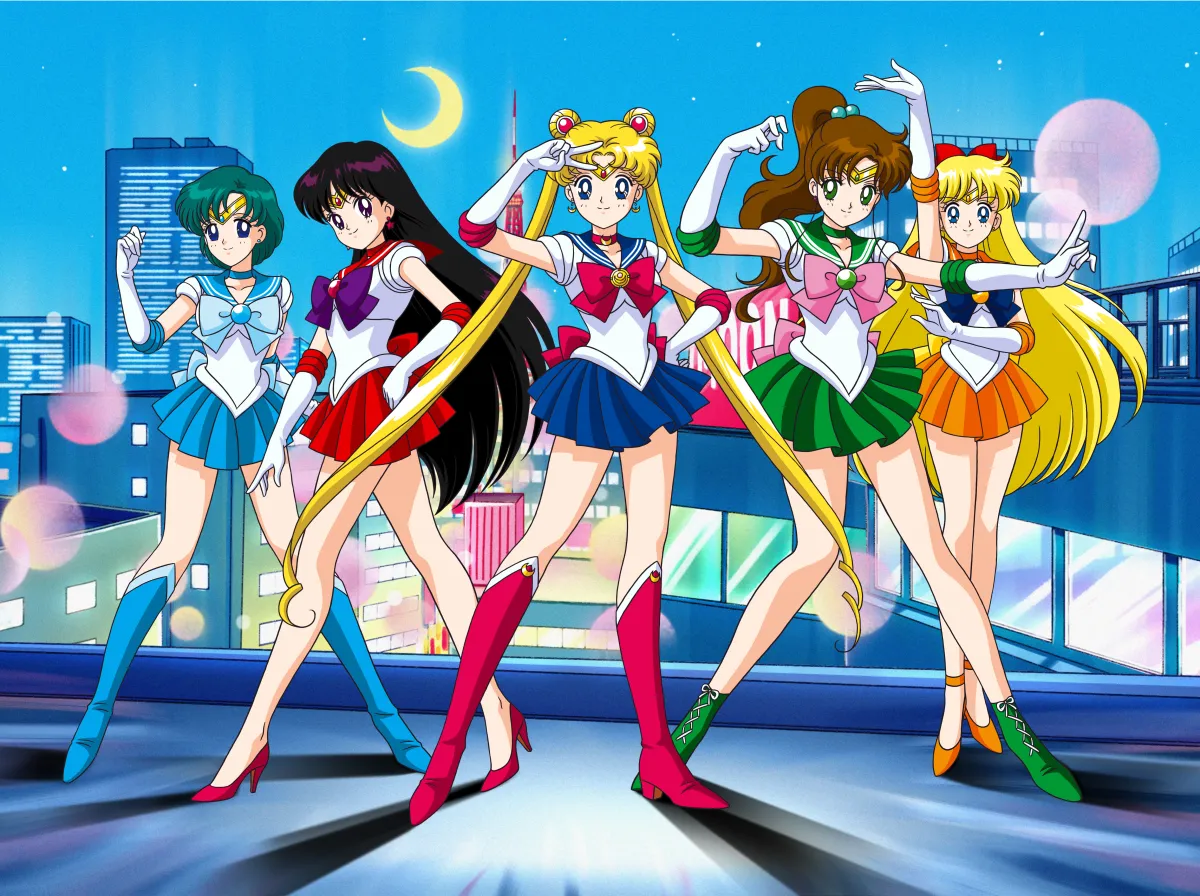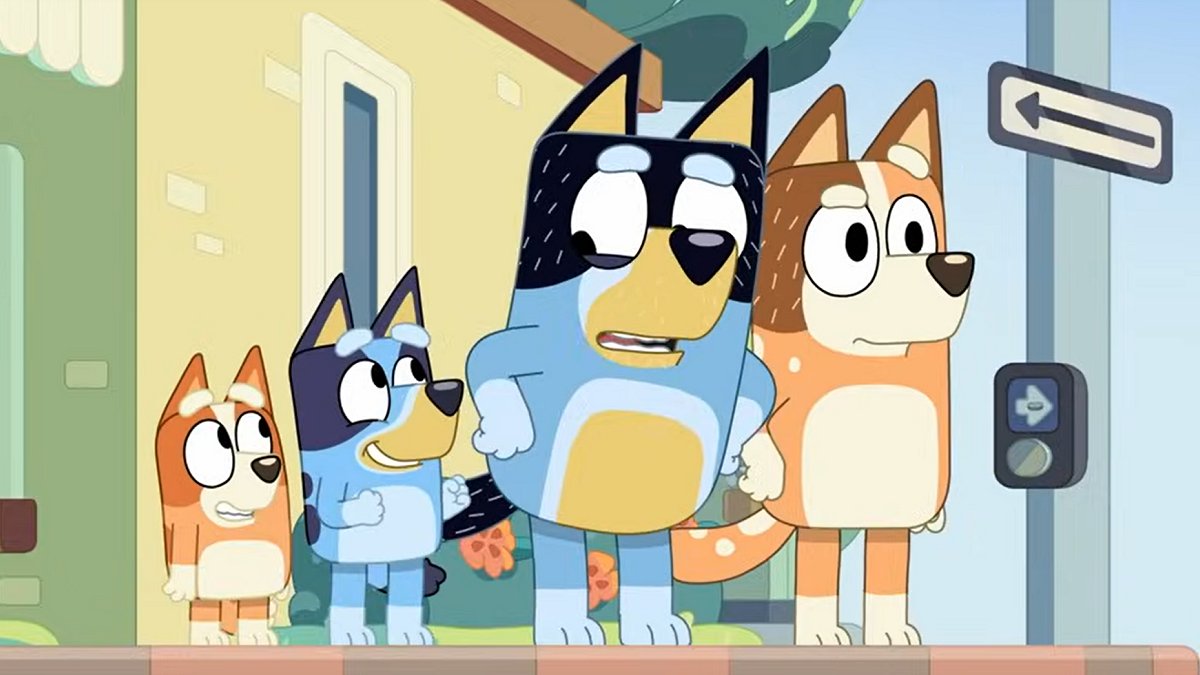Between Viz Media’s recent remastered release of the original mid ’90s anime, the upcoming 26-episode reboot set to hit the Internet in three weeks, and the ridiculous amounts of merchandise now for sale, it has never been a more exciting time to be a Sailor Moon fan. In honor of the new series, The Mary Sue will be taking a look at how Sailor Moon has grown over the past 20 years–starting, of course, with all the awesome Japanese stuff most of us couldn’t get at as kids.
For today, we’ll start by discussing the history of the franchise as it originally developed in Japan. Next week we will cover how the show was adapted for international audiences, with a special focus on Usagi’s transformation (for better or worse) into Serena for North American viewers. Finally, with only one week before Crystal airs on July 5th, we’ll discuss the role of fandom and online discussions in the world of Sailor Moon, as well as the sudden resurgence of senshi-themed merchandise.
Note: there will be some mild spoilers for each series in the franchise. If you know absolutely nothing about Sailor Moon and want a pure first-watching experience, our own Susana Polo is doing a series of newbie recaps (starting today!) for the anime if you’d like to follow along with her! The first 12 episodes are currently available on Hulu+ with more on the way, or you can also check out fan translations of the manga, live-action show, and musicals–yes, musicals— online as well. More on that later.
Edited to add: I was going to expand on the official Kodansha manga translations next week but somebody rightfully pointed out to us that you should absolutely seek out and support those very gorgeous editions before the fan translations I mention above. Sorry for the oversight on our part!
Before we really start to talk about Sailor Moon, though, we do also have to talk about Power Rangers.
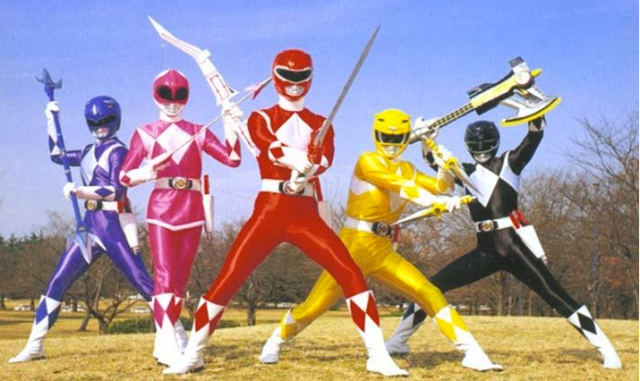
Yup, Usagi Tsukino and her gang of sailor guardians owe a lot to these guys. The first Super Sentai TV show aired in 1975 and spawned countless different spin-offs and series, including a particularly popular one from 1992 (Kyōryū Sentai Zyuranger) which eventually became the first Mighty Morphin Power Rangers when it came over to the United States. Most of these series consisted of five humans (mostly male, usually, because the franchise was geared towards young boys) who transform into color-coded superheroes and save the world from evil space invaders. Sound familiar? Because it should.
In an interview which appeared on the original Sailor Moon season one laserdisc, Sailor Moon creator Naoko Takeuchi said her ultimate goal was to “make a story like the Power Rangers series–a girls’ version–where the warriors go fighting upon the instructions from a Central Command Post. It didn’t turn out that way, though. Of course, from this concept came Sailor Moon. I had wanted to use five girls as the fighting warriors.”
More than anything else, this “fighting warrior” framework is what set Sailor Moon apart from its magical girl predecessors. The senshi weren’t just cute girls with magic powers; they used those powers primarily to fight monsters and protect the people of their planet. There’s a reason why the team is called senshi in Japan–while the term is typically translated now in current versions of the franchise as “guardians,” it can also mean “soldier.” Make no mistake about it, Sailor Moon and her friends will mess you up.
But Takeuchi didn’t actually begin with Sailor Moon. Just before Usagi arrived on the scene, there was an entire series devoted to her crimefighting idol and future partner-in-justice, Sailor V.
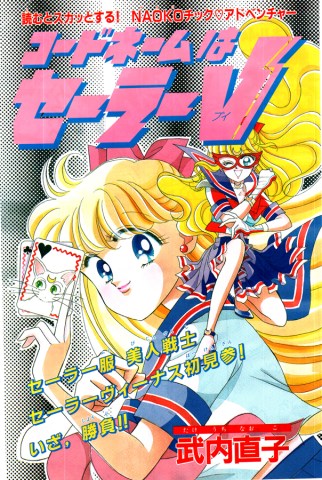
From RunRun Magazine, August 1991
Codename Wa Sailor V started out pretty much the same way its successor did: Minako Aino is a regular schoolgirl who gets discovered by Artemis, a talking cat, and told she must save the world from evil as an incarnation of the goddess Venus. The series first began in 1991 as a one-shot storyline in Nakayoshi, but continued on in RunRun magazine until 1994, running concurrently with Sailor Moon for a number of years and ending just after the first SM story did.
On the whole the series is much lighter than its successor and involves Minako saving her fellow Tokyo citizens from “Dark Agency,” narrowly avoiding being uncovered by the local Juuban district police force, and developing ridiculous crushes on very attractive guys. It also features some adorable cameos from Sailor Moon regulars:
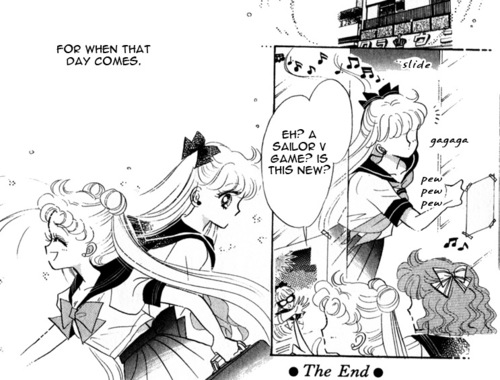
From the 2011 Kodansha Press translation of “Volume 5: The Machinations of the Dark Agency”
While Takeuchi was developing Bishoujo Senshi Sailor Moon around the same time as Codename Wa Sailor V, Usagi’s story did not start running in Nakayoshi magazine until December of that year, more than six months after its prequel began. The switch from Minako to Usagi was part of a deal with Toei Animation, who eventually produced the anime version of Sailor Moon. They “wanted to see a group of girls joined together,” obviously hoping to capitalize on the Super Sentai craze (source).
Rather than save the day as the lead protagonist, Minako shuffles into a role as leader of the senshi and commanding general-of-sorts, while Usagi ascends to a more monarchal supreme ruler position. Within the context of the story, it works wonderfully; just as the team stumbles together, Venus arrives as the experienced, battle-hardened soldier to guide them towards their destinies, and even serves as a decoy Moon princess for a few chapters to allow Usagi more time to grow as a heroine.
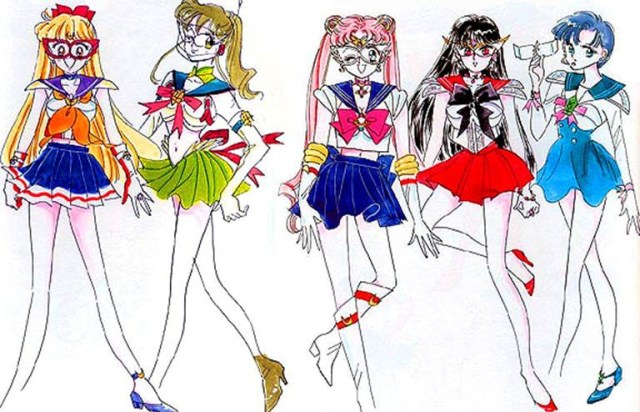
Early concept art of the inner senshi, including Sailor V (via Moon Sisters)
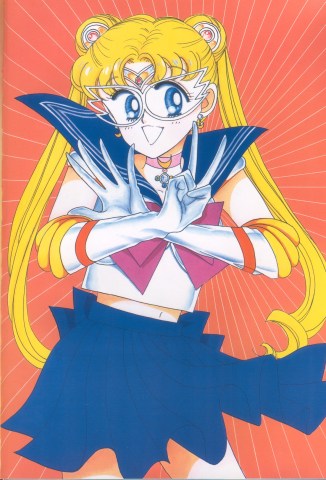
Another concept image for a potential Nakayoshi cover. Takeuchi says In Volume I of the Art Book collection: “At first, I planned to have Sailor Moon’s hair be yellow before transforming, and silver after transforming. But I was told by the editor in charge of the front cover, Silver is plain for use on the cover. Yellow is definitely more flashy, and it will stand out. Since then I feel my way of thinking about my color pictures has completely changed.”
The manga was only meant to consist of one story arc–Sailor Moon realizing her fate as princess and defeating the Dark Kingdom with the help of her friends and lover, Tuxedo Kamen– but at the behest of Nakayoshi publisher Kodansha and Toei Animation, this grew to five story arcs over 52 “acts;” five art books which feature gorgeous, high-fashion inspired images of the characters; and ten lighthearted side-stories which act as filler. There’s even one with a vampire demon, which was also later turned into an anime special. It’s kind of the best.
Toei Animation, meanwhile, began running the Sailor Moon anime in March of 1992. Again, it wasn’t the first magical series series in existence, but it’s focus on a Super Sentai-style team of five fighters heavily influenced the genre and cemented Sailor Moon’s place as one of the most influential animes of all time. It was the first magical girl show to make it to North American television audiences, too, but we’ll get to that next week.
Despite running almost concurrently with the manga, the anime’s plot and tone differ drastically from the original source material; most notably, it changes up some of the personalities of the characters to makes them a bit more dynamic and vibrant. Where Manga!Rei is cool and collected, Anime!Rei is hotheaded and passionate; where Manga!Mamoru is sort of generically handsome and supportive–Naoko envisioned him to be the ideal boyfriend and sometimes remarks that he’s her favorite character–Anime!Mamoru is kind of a dork at times. And where Usagi quickly blossoms into an elegant lady in the manga, in the anime she’s just a bit ditzier and more of a crybaby for a longer stretch of time.
Despite loving the manga deeply and knowing not all the changes made to the anime were appreciated, I like to think this is what makes the anime the quintessential and most easily-recognizable form of the franchise–though the sheer length probably helps as well. After all, 200 episodes and 3 full-length movies will make anything pretty ubiquitous.
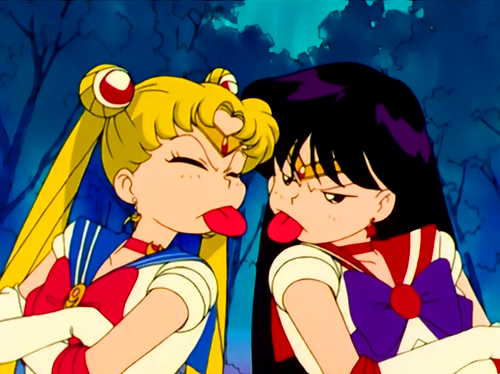
From the first season of the anime, circa 1993.
Which isn’t to say that there weren’t other forms of Sailor Moon that ran even longer. While the manga and the anime were still being released in the mid-90s, a series just under 30 different musicals were also produced in Japan, the first in 1993 and the last in 2005. Over ten years of senshi-themed musicals! And you thought it couldn’t get any more beautifully, beautifully dorky.
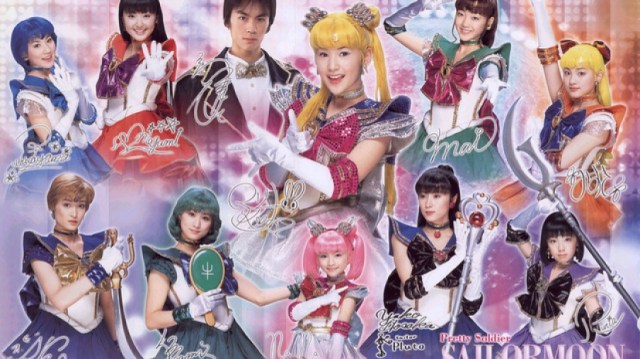
Sera Myu is my weakest area of Sailor Moon knowledge, so if someone can source this image to the proper musical and timeframe for me, that’d be awesome. I’m guessing circa 2002? (via HeroOtaku)
These shows, collectively called Sera Myu (short for “Sailormoon Musical”), were performed multiple times over each year and borrowed heavily from both the anime and manga. Of course, once both series ended in 1997, the musicals kind of started doing their own thing. This included creating new characters, such as Sailor Astarte, Sailor Vulcan, and Blood Dracul Vampir, who is the daughter of Dracula. You know, from the four-part series of musicals from 2000-01 where the senshi fight Dracula, who is also Abel from biblical lore. Sailor Moon and ancient Old Testament vampires, who knew?
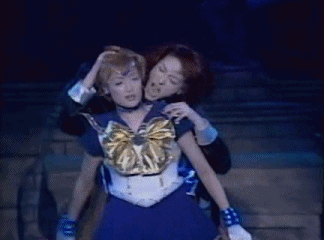
Anyone up for a Penny Dreadful crossover fic?
Oh, and there were a lot of Sailor Moon video games released during the ’90s, too. Like, a lot, from side-scrollers to puzzles and even fighting games. For me, the most notable of the bunch was Sailor Moon: Another Story, a JPRG which took place just after the Muugen Infinity Arc/Sailor Moon S. You can find English-translated emulators of the game online if you’re so inclined. I highly recommend it.
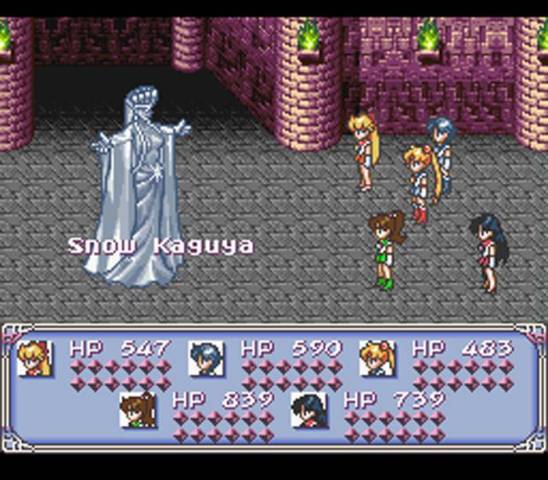
The game also involved you fighting literally every villain the senshi had ever encountered, including movie monsters like Princess Snow Kaguya. (via Gamefaqs)
Eventually the franchise even went full circle into a Super Sentai-inspired Tokusatsu live-action show in 2003, which was produced by Toei in honor of the anime’s tenth anniversary (the manga was also rereleased around the same time). Pretty Guardian Sailor Moon, as it’s known, was a completely different interpretation of the series. Among other things, it depicted Minako as a very serious and mission-oriented pop idol, and Luna as a sometimes CGI animated plush doll. Sometimes she was not a GCI animated plush doll, which was kinda worse. I love PGSM and all, but I do not want to get into it.
Also, the costumes. Oh man, the costumes. You kind of have to just see it for yourself.
After PGSM wrapped up in 2004 and the last Sera Myu performance ended in 2005, things were pretty quiet for a couple of years–that is, right until the franchise’s 20th birthday in 2012. That’s when Sailor Moon Crystal was announced, and soon on it’s moon-booted heels came a second anniversary manga rerelease and a new Takarazuka musical (that’s a particular genre of Japanese theater where women play all the parts, including male characters. Take that, Elizabethan England!) called La Reconquista. There’s even another one on the way that’s based on the Black Moon Family/Sailor Moon R.
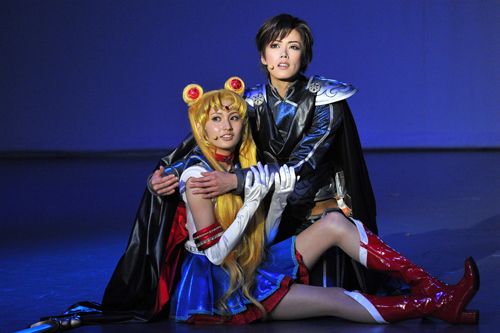
Satomi Okubo as Usagi/Sailor Moon and Yue Yamato as Mamoru/Prince Endymion. (via Broadway World)
Since the tenth anniversary, Naoko Takeuchi has also become much more involved with the franchise than she originally was with Toei Animation (she famously took issue with some of the changes made to the show’s final season, in particular the switching of several character’s genders). She contributed several character designs to PGSM, helped with the casting of the recent musicals, and was reportedly instrumental in creating the Crystal reboot.
And speaking of that Crystal reboot: you’d better believe people are pumped about it, in no small part because it’s target audience is still the women who grew up with Sailor Moon in the early ’90s. “We’d like the girls who have become adults to immerse themselves in the dream world of “Sailor Moon” all over again,” director Munehisa Sakai said in a recent Animedia article. “Rather than making them feel nostalgic, we want them to once again experience that dream-like feeling they felt when they looked up to the Sailor Guardians. We’d like them to become even more engulfed in that dream world with the new show.”
It’s certainly no small feat, and already people are worried that the new reboot might not live up to the hype. But I want to believe that even if Crystal fails to inspire the same level of awe in us as full-grown cynical adults, at the very least it will usher in a new generation of kids who’ll love it as much as we did without needing to know the source material, just in the same way some fans only learned about Usagi through Sera Myu performances or by watching the live-action series. As long as people keep watching, reading, and getting inspired by stories about powerful female superheroes who save the world with their their friendship and love for one another, then that’s 100% good enough for me.
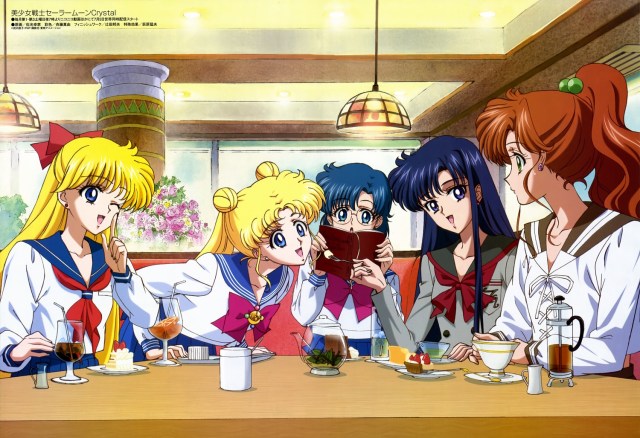
A poster from the July issue of Animedia. (via Miss Dream)
Next week: Did you know that before anybody thought to just dub over the original Japanese series, an animation company in North America tried to create their own version of Sailor Moon? Yeah, it’s bonkers. Get ready to hear me talk about it ad nauseum.
- In the Name of the Moon, the First Sailor Moon Crystal Trailer Is Here
- Official Sailor Moon Premiere Party Excludes Unaccompanied Men
- This Is Not A Drill: All 200 Uncut Episodes Of Sailor Moon Are Coming To DVD, Blu-ray, And Hulu
Are you following The Mary Sue on Twitter, Facebook, Tumblr, Instagram, & Google +?



